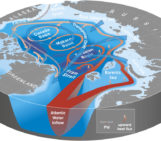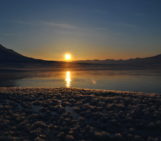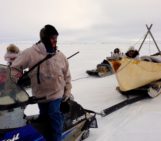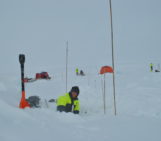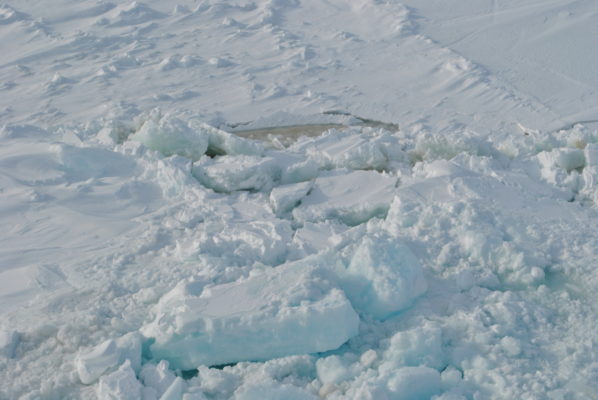
There, what is this, spoke the sea ice algae. Is this the first light of dawn? Is it finally this time of the year again? Spring…the best time of the year…the BBQ season? And in the little brine pockets all around the sea ice, the bacterial and archaeal community stirred alive. BBQ? Did somebody mention BBQ? Let’s have some vegan burgers! And so spring began inside of the Arctic sea ice.
A journey to the North
Imagine you live in an environment where you have only two seasons. Not like the tropics, where you have the rain and dry season. No, the Arctic, where you have the dark and cold winter, where no light dwells, and the not-so-cold-but-still-cold summer, where the midnight sun robs you from your sleep. This is where I will take you today, into the sea ice, or more precise, the lowest part of the ice. We are talking about the approx. 10 cm of ice that is in direct contact with the water. Here, a lot of microbes are living (Figure 1). Microbes, that is bacteria, archaea, and also single cell algae (we also met some of them in permafrost soils and on the surface of glaciers, do you remember?). Never heard of archaea before? For simplicity, let’s say they look and act mostly like bacteria, but they are closer related to us. But back to the ice. Who exactly lives at the bottom of sea ice? And how do they behave when seasons change? To answer those questions, we went out during a project called the Norwegian Young Sea Ice Expedition 2015 or N-ICE2015. The expedition went into the Arctic sea ice north of the island group Svalbard (Norway) and stayed in the ice for almost 6 months to investigate the ice and the microbial communities living there. The most interesting things to look at here were the community composition and how it changes from the dark winter to light spring and early summer.
The calm before the feast
So let us start in winter. What we find there is a bacterial and archaeal community, but rarely any sea ice algae. This is not surprising, since algae love sun and need light to grow. But what we find are archaea called Candidatus Nitrosopumilus in high relative abundance (yellow dots in Figure 2). These archaea are known to use ammonia and produce nitrite, two nitrogen compounds. Therefore, we assume that in winter, there is a lot of ammonia transferred into nitrite and later into nitrate. As proteins have a lot of nitrogen compounds and meat has a lot of protein, let us call them the carnivores. Just keep in mind that they don’t literally eat meat. They are peaceful critters, as most microbes actually are. Still, in winter there is likely a lot of nitrogen cycling; they basically feast upon the Christmas roasts. But then the sun shows her face over the horizon and seasons change…
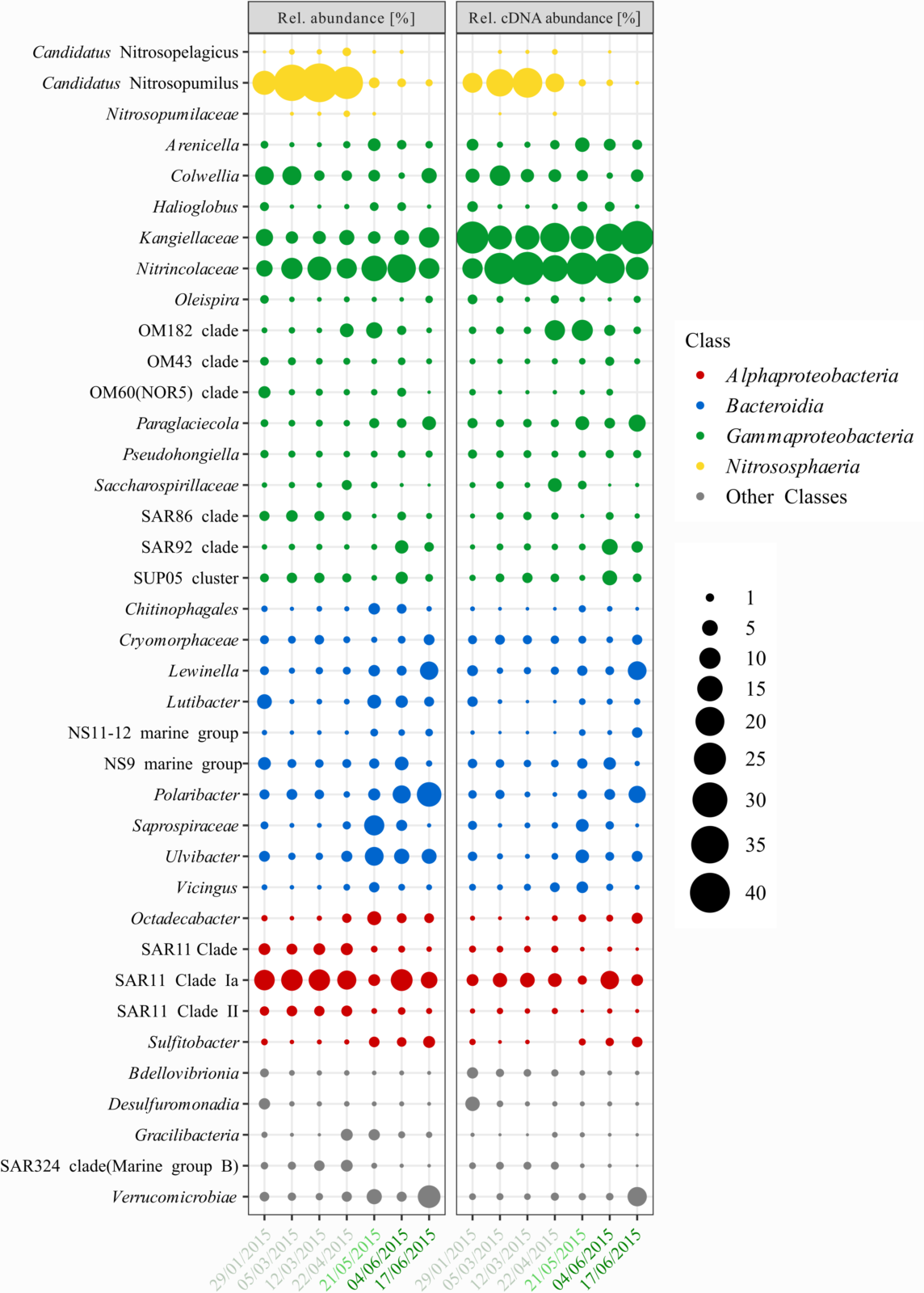
Figure 2: The guests – The transition of the bacterial and archaeal community from winter to the BBQ season in spring and early summer. The relative abundance shows, which group of organisms (colour of the dots) made up what percentage of the community (size of the dots), the relative cDNA abundance indicates how active (again size of the dots) they were (aka how viciously they devour the burgers). The color of the dates indicates the strength of the sea ice algae bloom. In winter (light green) the bloom has not started, in spring (green) the bloom starts, and is highest in early summer (dark green). [credit: Thiele et al., 2022]
Setting the table
When light comes back to the Arctic and the temperatures increase in spring, the sea ice algae stir alive and start growing, because they like higher temperatures and need light to produce biomass. This is very similar to fields where different crops are starting to grow in spring. Crops like soybeans, peas, beans, and other nice veggies that can be turned into vegan burgers. In the Arctic this means, we will see a bloom of sea ice algae in the bottom part of the ice (Figure 1). This bloom consists mostly of one species of single cell sea ice algae, but they produce a lot of different carbon compounds like sugars, which are all very yummy for the bacterial and archaeal cells around. And so the BBQ season begins.
Welcome to the BBQ
In spring and early summer, the sea ice algae grow and provide a rich board of nice burgers to the BBQ. Since it is a vegan BBQ by default (algaes are plants in the end), the first to disappear from the party are the carnivores. Interestingly, we find almost no trace of Candidatus Nitrosopumilus anymore. Instead, the vegans come out of their winter sleep. These are, among others, bacteria belonging to the classes Gammaproteobacteria (green dots in Figure 2) and Bacteroidia (blue dots). These two classes are both well known to metabolise a variety of carbon sources derived from algae, and they grow using these carbon sources. But they don’t grow all at the same time, but rather in a succession based on the availability of their favourite food source. Similar to your garden party when you put different burger patties on to the fire.
The order of the feast
Let us say you put the soybean burger first, then you will see the soybean-loving-people coming to pick up food first. Let us say these are mostly the Gammaproteobacteria. Then you put some bean burgers, some vegetable skewers, and some beetroot burgers on, and the Bacteroidia come in. But always one after the other, depending on what is ready. For example, Ulvibacter really likes bean burgers, so they come in early, Polaribacter prefers skewers and beet root, so they come second and stay until the end, Lentimonas likes only beetroot and comes last, but Nitrincolaceae like all of it (but mostly skewers), so they are constantly at the grill. And once you run out of the good stuff, you still have the cheap, dry burgers left, put them on, the Verrucomicrobiae (grey dots) will be happy, since they like more complex carbon structures. And this is exactly what we see in sea ice. The moment the sea ice algae bloom, different groups of bacteria begin to stir and grow based on the carbon availability (Figure 2). So when the seasons change, the community shifts from mainly nitrogen metabolism to mainly carbon metabolism and a succession of different taxa starts based on their carbon preferences and the ecological niche these carbon sources provide. And so they live happily into the summer until darkness falls and winter comes again. But what happens in this transition we really don’t know yet. But maybe, one fine day, we will go out again and see who is at the BBQ in fall and ones the darkness returns to the ice.
…and don’t forget the joker
Wait a minute, before you close this down, Zwiebel. I see a lot of yellow in winter and green, blue, and some grey in summer there, but you haven’t talked about the red, you may say. True…well, the red is mostly a group called SAR11. This group is the most abundant group of organisms on the planet, but we don’t really understand them yet. For now, let’s call them the bar guys. They are always there, drinking their beer, but don’t really participate in the feast. No matter what you dish up, they probably stick to the peanuts on the bar.
Further reading
- Thiele et al. (2022) A winter-to-summer transition of bacterial and archaeal communities in Arctic sea ice, Microorganisms 10:1618
- Wietz et al. (2021) The polar night shift: seasonal dynamics and drivers of Arctic Ocean microbiomes revealed by autonomous sampling. ISME Commun 1:1–12
- Previous Cryoblog posts about microbes in permafrost soils and on the surface of glaciers
Edited by Loeka Jongejans and Giovanni Baccolo
 Stefan “Zwiebel” Thiele is a postdoc at the University of Bergen, Norway. He investigates bacterial and archaeal communities in Arctic environments such as sea ice, the marine pelagic environment or pingos in Svalbard. In addition to the polar work, Stefan also works on smaller projects regarding other bacterial and archaeal communities, e.g. in cave sediments in the Bahamas. In his free time, he conducts a second master of science in Environmental Science, where he works with microplastic in the ocean. Contact Email: stefan.thiele@uib.no
Stefan “Zwiebel” Thiele is a postdoc at the University of Bergen, Norway. He investigates bacterial and archaeal communities in Arctic environments such as sea ice, the marine pelagic environment or pingos in Svalbard. In addition to the polar work, Stefan also works on smaller projects regarding other bacterial and archaeal communities, e.g. in cave sediments in the Bahamas. In his free time, he conducts a second master of science in Environmental Science, where he works with microplastic in the ocean. Contact Email: stefan.thiele@uib.no

